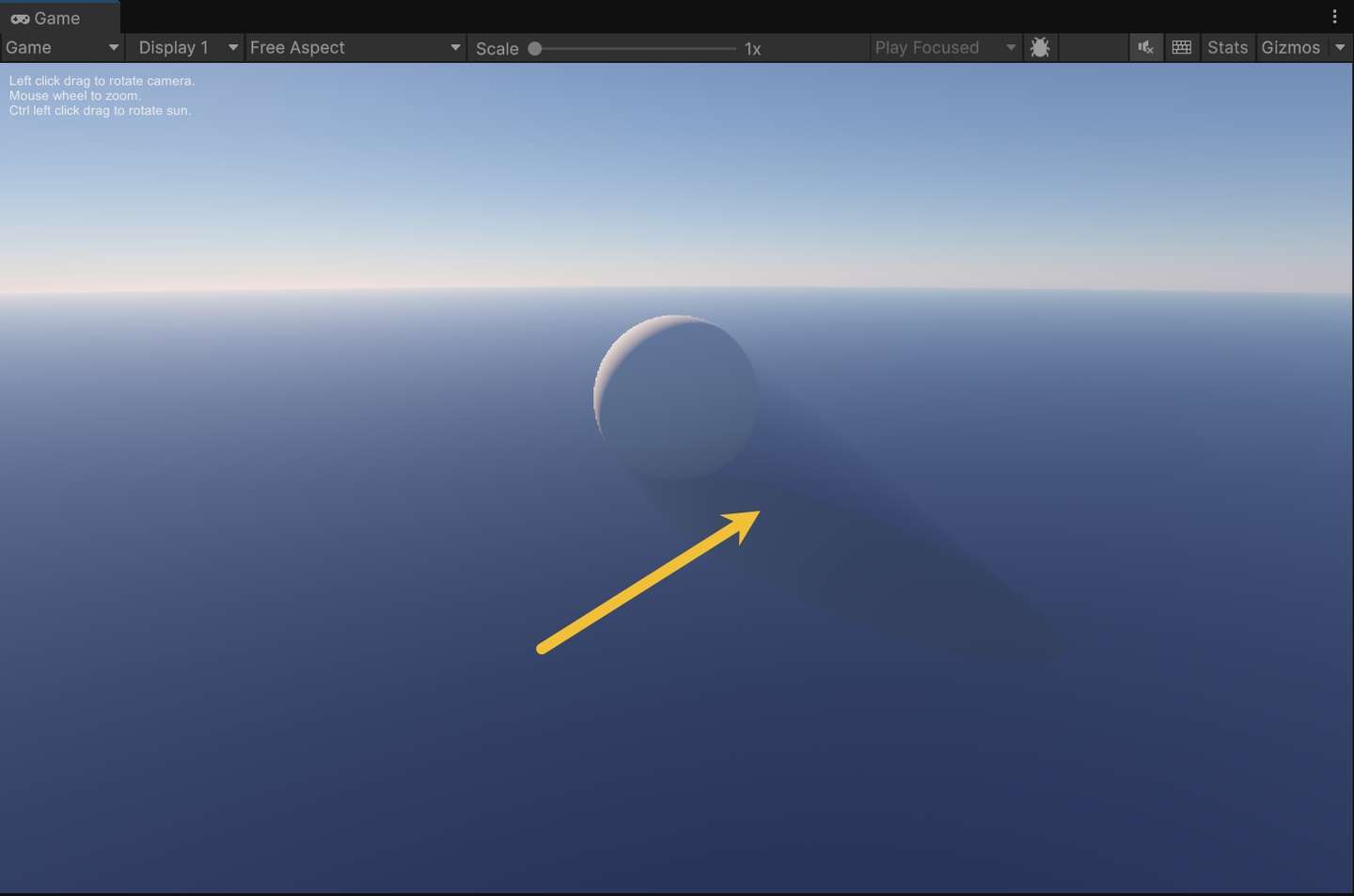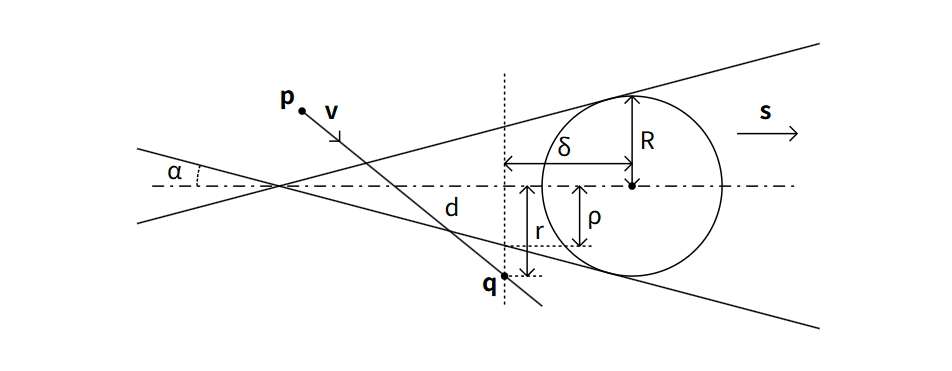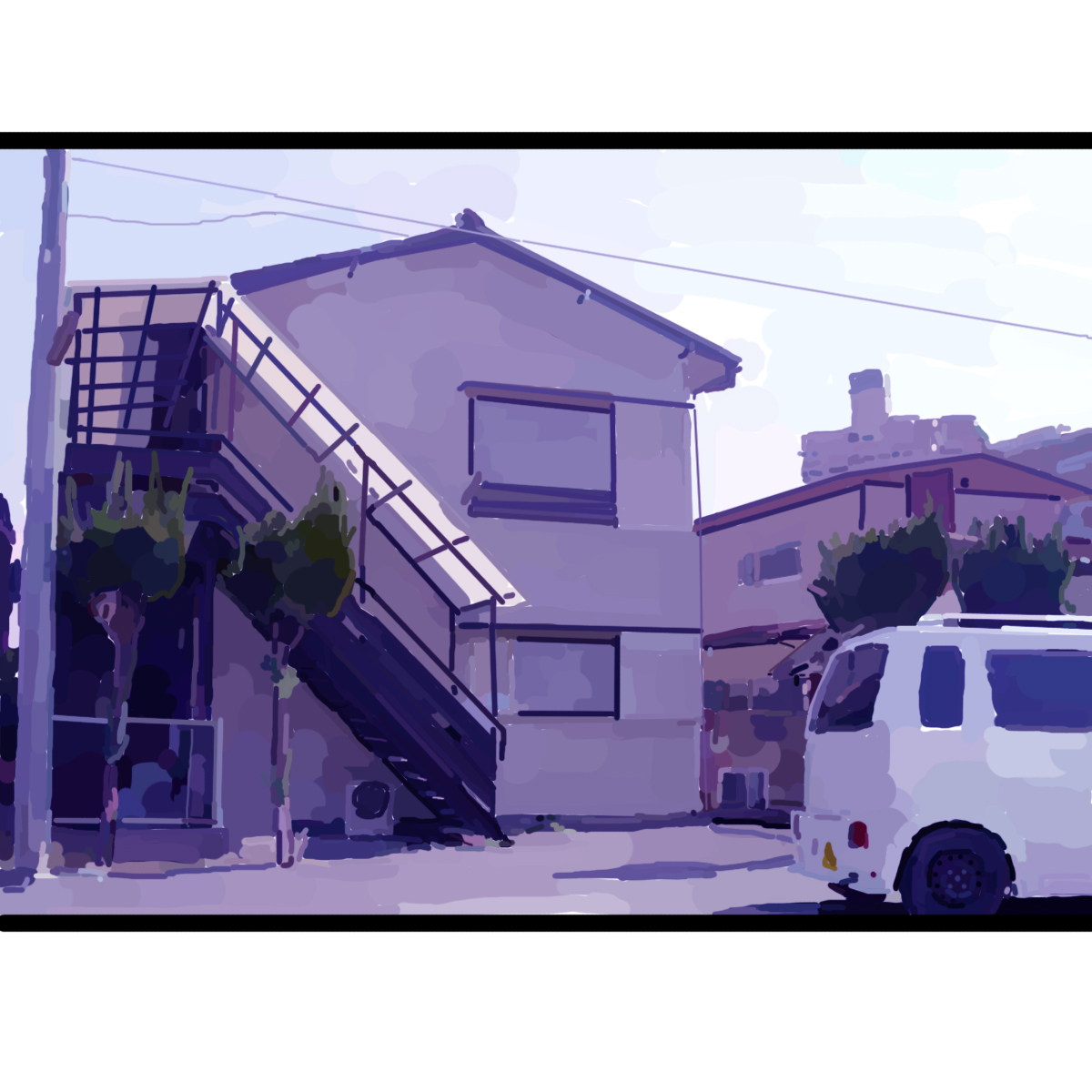函数们
求太阳可见度
float GetSunVisibility(float3 _point, float3 sun_direction)
{
float3 p = _point - kSphereCenter;
float p_dot_v = dot(p, sun_direction);
float p_dot_p = dot(p, p);
float ray_sphere_center_squared_distance = p_dot_p - p_dot_v * p_dot_v;
float distance_to_intersection = -p_dot_v - sqrt(max(0.0, kSphereRadius * kSphereRadius - ray_sphere_center_squared_distance));
if (distance_to_intersection > 0.0)
{
// Compute the distance between the view ray and the sphere, and the
// corresponding (tangent of the) subtended angle. Finally, use this to
// compute an approximate sun visibility.
float ray_sphere_distance = kSphereRadius - sqrt(ray_sphere_center_squared_distance);
float ray_sphere_angular_distance = -ray_sphere_distance / p_dot_v;
return smoothstep(1.0, 0.0, ray_sphere_angular_distance / sun_size.x);
}
return 1.0;
}我画一个几何来表示上面在干什么:
p1,p2,p3是三种不同情况下的视线点,只有p3会形成遮挡

最后的float ray_sphere_angular_distance = -ray_sphere_distance / p_dot_v;本质上是求ray_sphere_distance 和p_dot_v形成的直角三角形的某一个角的tan值。
然后再除以sun_size.x(这里的sun_size.x是Mathf.Tan(kSunAngularRadius)),也是一个tan值,得到球是否完全覆盖太阳盘,形成软阴影。
天空可见度
球也可以遮挡住部分天空,这里的可见度也需要计算
球体引起的环境光衰减因子由辐射视因子(Isidoro Martinez, 1995)给出。在球体完全可见的简单情况下,天空可见度由以下函数给出:
float GetSkyVisibility(float3 _point)
{
float3 p = _point - kSphereCenter;
float p_dot_p = dot(p, p);
return 1.0 + p.y / sqrt(p_dot_p) * kSphereRadius * kSphereRadius / p_dot_p;
}
公式
光柱

void GetSphereShadowInOut(float3 view_direction, float3 sun_direction, out float d_in, out float d_out)
{
float3 camera = _WorldSpaceCameraPos;
float3 pos = camera - kSphereCenter;
float pos_dot_sun = dot(pos, sun_direction);
float view_dot_sun = dot(view_direction, sun_direction);
float k = sun_size.x; //Mathf.Tan(kSunAngularRadius)
float l = 1.0 + k * k;
float a = 1.0 - l * view_dot_sun * view_dot_sun;
float b = dot(pos, view_direction) - l * pos_dot_sun * view_dot_sun -
k * kSphereRadius * view_dot_sun;
float c = dot(pos, pos) - l * pos_dot_sun * pos_dot_sun -
2.0 * k * kSphereRadius * pos_dot_sun - kSphereRadius * kSphereRadius;
float discriminant = b * b - a * c;
if (discriminant > 0.0)
{
d_in = max(0.0, (-b - sqrt(discriminant)) / a);
d_out = (-b + sqrt(discriminant)) / a;
// The values of d for which delta is equal to 0 and kSphereRadius / k.
float d_base = -pos_dot_sun / view_dot_sun;
float d_apex = -(pos_dot_sun + kSphereRadius / k) / view_dot_sun;
if (view_dot_sun > 0.0)
{
d_in = max(d_in, d_apex);
d_out = a > 0.0 ? min(d_out, d_base) : d_base;
}
else
{
d_in = a > 0.0 ? max(d_in, d_base) : d_base;
d_out = min(d_out, d_apex);
}
}
else
{
d_in = 0.0;
d_out = 0.0;
}
}
由于太阳不是点光源(α 为太阳的角半径),阴影体积不是一个圆柱,而是一个圆锥

如上图所示,以圆心为0坐标点,p 为相机位置,v 和 s 分别为单位视线向量和太阳方向向量,R 为球体半径(假设球心位于原点)。距离相机 d 的点为 q = p+ dv。该点沿本影圆锥轴方向距离球心 δ =-q·s,偏离该轴的距离由r 给出。最终,在轴方向距离处,本影圆锥的半径为ρ= R-tanα,其中 α 为太阳的角半径。距离相机 d 的点位于阴影圆锥上,当且仅当r² = ρ² 时:

展开后,可以得到d的二次方程:

其中:

太阳直射和天空散射
IrradianceSpectrum GetSunAndSkyIrradiance(
TransmittanceTexture transmittance_texture,
IrradianceTexture irradiance_texture,
Position pos,
Direction normal,
Direction sun_direction,
out IrradianceSpectrum sky_irradiance)
{
// 1) 先算出当前点到星心(地心)距离 r
Length r = length(pos);
// 2) mu_s = cos(太阳天顶角) = (p·s) / |p|
Number mu_s = dot(pos, sun_direction) / r;
// 3) 【漫散射(Indirect)部分】从预计算的 irradiance 2D 纹理里查
// GetIrradiance(irradiance_texture, r, mu_s) 本身就是
// ∫L_sky(θ,φ)·cosθ ·dω
// 但那个是针对“水平面”的辐照,我们对任意法线加个近似修正:
// * (1 + cos θ_surface)/2
// 其中 cos θ_surface = dot(normal, pos)/r 表面法线与“上正方向”(pos) 的夹角余弦
sky_irradiance = GetIrradiance(irradiance_texture, r, mu_s)
* (1.0 + dot(normal, pos)/r) * 0.5;
// 4) 【直射(Direct)部分】
// solar_irradiance —— 顶层大气的太阳谱辐照度 (W/m²)
// GetTransmittanceToSun(...) —— 从 p 看向太阳方向的衰减 (0–1)
// max(dot(normal, sun_direction),0) —— Lambert 面对太阳法线余弦项
//
// 结果就是传出的“直射辐照度”:
return solar_irradiance
* GetTransmittanceToSun(transmittance_texture, r, mu_s)
* max(dot(normal, sun_direction), 0.0);
}
DimensionlessSpectrum GetTransmittanceToSun(TransmittanceTexture transmittance_texture, Length r, Number mu_s)
{
Number sin_theta_h = bottom_radius / r;
Number cos_theta_h = -sqrt(max(1.0 - sin_theta_h * sin_theta_h, 0.0));
Number step = smoothstep(-sin_theta_h * sun_angular_radius / rad, sin_theta_h * sun_angular_radius / rad, mu_s - cos_theta_h);
return GetTransmittanceToTopAtmosphereBoundary(transmittance_texture, r, mu_s) * step;
}RenderSky
/// <summary>
/// 计算沿视线 (view_ray) 在大气层中所看到的天空散射辐射,并输出从摄像机到大气顶端的透射率。
/// 基于 Bruneton & Neyret 《Precomputed Atmospheric Scattering》模型实现。
/// </summary>
RadianceSpectrum GetSkyRadiance(
TransmittanceTexture transmittance_texture, // 预计算透射率纹理
ReducedScatteringTexture scattering_texture, // 预计算多次散射纹理
ReducedScatteringTexture single_mie_scattering_texture,// 预计算单次 Mie 散射纹理
Position camera, // 摄像机位置(以地心为原点的世界坐标)
Direction view_ray, // 视线方向(单位向量)
Length shadow_length, // 光柱(光轴)特效,需要跳过的初始散射长度(无特效时为 0)
Direction sun_direction, // 太阳方向(单位向量)
out DimensionlessSpectrum transmittance // 输出:摄像机到大气顶端的透射率
)
{
//====================================================
// 1. 处理摄像机在大气层外的情况
//====================================================
Length r = length(camera); // 摄像机到地心的距离 r
Length rmu = dot(camera, view_ray); // 视线方向与 camera 向量的投影长度 r·μ
// 计算视线与大气最外层(半径 top_radius)的交点距离 t
// 解射线—球相交方程:t^2 + 2*rmu*t + (r^2 - top_radius^2) = 0
Length distance_to_top_atmosphere_boundary =
-rmu - sqrt(rmu*rmu - r*r + top_radius*top_radius);
// 如果摄像机在大气层外并且视线会进入大气
if (distance_to_top_atmosphere_boundary > 0.0 * m)
{
// 将观察点沿视线移动到大气顶端,方便后续统一为大气内部计算
camera = camera + view_ray * distance_to_top_atmosphere_boundary;
r = top_radius; // 更新半径 r 为大气顶端半径
rmu += distance_to_top_atmosphere_boundary; // 更新投影长度 r·μ
}
else if (r > top_radius)
{
// 如果摄像机在大气外且视线不穿入大气,则没有散射,完全透射
transmittance = DimensionlessSpectrum(1, 1, 1);
return RadianceSpectrum(0, 0, 0);
}
//====================================================
// 2. 计算纹理查找所需的参数 (r, μ, μ_s, ν)
//====================================================
Number mu = rmu / r; // μ = cos(theta_v):视线与径向的余弦
Number mu_s = dot(camera, sun_direction) / r; // μ_s = cos(theta_s):太阳方向与径向的余弦
Number nu = dot(view_ray, sun_direction); // ν = cos(phi):视线与太阳方向的余弦
bool ray_r_mu_intersects_ground = RayIntersectsGround(r, mu);
//====================================================
// 3. 获取从摄像机到大气顶端的总透射率 T(r, μ)
//====================================================
if (ray_r_mu_intersects_ground)
{
// 如果视线会击中地面,透射率为零
transmittance = DimensionlessSpectrum(0, 0, 0);
}
else
{
// 否则从预计算透射纹理中查表
transmittance = GetTransmittanceToTopAtmosphereBoundary(
transmittance_texture, r, mu);
}
//====================================================
// 4. 计算散射贡献
// 包含 Rayleigh + 多次 Mie 散射,以及单次 Mie 散射
//====================================================
IrradianceSpectrum single_mie_scattering; // 用于存储单次 Mie 散射
IrradianceSpectrum scattering; // 存储总散射辐照度
if (shadow_length == 0.0 * m)
{
// 普通情况:无光柱特效,直接查 Rayleigh+Mie 散射合并结果
scattering = GetCombinedScattering(
scattering_texture,
single_mie_scattering_texture,
r, mu, mu_s, nu,
ray_r_mu_intersects_ground,
single_mie_scattering);
}
else
{
// 光柱特效:跳过前段散射,参考论文公式 (18)
Length d = shadow_length; // 需要跳过的散射起点距离
// 计算跳过后位置的半径 r_p 与余弦 μ_p, μ_s_p
Length r_p = ClampRadius(
sqrt(d*d + 2.0*r*mu*d + r*r));
Number mu_p = (r*mu + d) / r_p;
Number mu_s_p = (r*mu_s + d*nu) / r_p;
// 在新位置调用相同散射查表
scattering = GetCombinedScattering(
scattering_texture,
single_mie_scattering_texture,
r_p, mu_p, mu_s_p, nu,
ray_r_mu_intersects_ground,
single_mie_scattering);
// 计算前段阴影区间的透射率并乘到散射值上
DimensionlessSpectrum shadow_transmittance =
GetTransmittance(
transmittance_texture,
r, mu,
shadow_length,
ray_r_mu_intersects_ground);
scattering *= shadow_transmittance;
single_mie_scattering *= shadow_transmittance;
}
//====================================================
// 5. 按相函数加权并输出最终天空辐射
//====================================================
// 瑞利相函数加权
RadianceSpectrum rayleigh_part = scattering * RayleighPhaseFunction(nu);
// Mie 相函数加权单次 Mie 散射
RadianceSpectrum mie_part = single_mie_scattering * MiePhaseFunction(mie_phase_function_g, nu);
// 两者相加并返回
return rayleigh_part + mie_part;
}
讲解一下
这里的
// 如果摄像机在大气层外并且视线会进入大气
if (distance_to_top_atmosphere_boundary > 0.0 * m)
这里计算的二次方程的根,是取小的那一个根,也就是说,如果相机在内部,那么根一定是小于0的。
若t大于0,视线与大气顶端的交点在相机前方,所以视线一定是从外面射入进来的。
以及
Length d = shadow_length; Length r_p = ClampRadius(sqrt(d d + 2.0 r mu d + r r));
Number mu_p = (r mu + d) / r_p; Number mu_s_p = (r mu_s + d nu) / r_p;
是把相机往前移动了shadow_length后的新坐标
设置Rendertexture顶点
float CAMERA_FOV = camera.fieldOfView;
float CAMERA_ASPECT_RATIO = camera.aspect;
float CAMERA_NEAR = camera.nearClipPlane;
float CAMERA_FAR = camera.farClipPlane;
Matrix4x4 frustumCorners = Matrix4x4.identity;
float fovWHalf = CAMERA_FOV * 0.5f;
Vector3 toRight = camera.transform.right * CAMERA_NEAR * Mathf.Tan(fovWHalf * Mathf.Deg2Rad) * CAMERA_ASPECT_RATIO;
Vector3 toTop = camera.transform.up * CAMERA_NEAR * Mathf.Tan(fovWHalf * Mathf.Deg2Rad);
Vector3 topLeft = (camera.transform.forward * CAMERA_NEAR - toRight + toTop);
float CAMERA_SCALE = topLeft.magnitude * CAMERA_FAR / CAMERA_NEAR;
topLeft.Normalize();
topLeft *= CAMERA_SCALE;
Vector3 topRight = (camera.transform.forward * CAMERA_NEAR + toRight + toTop);
topRight.Normalize();
topRight *= CAMERA_SCALE;
Vector3 bottomRight = (camera.transform.forward * CAMERA_NEAR + toRight - toTop);
bottomRight.Normalize();
bottomRight *= CAMERA_SCALE;
Vector3 bottomLeft = (camera.transform.forward * CAMERA_NEAR - toRight - toTop);
bottomLeft.Normalize();
bottomLeft *= CAMERA_SCALE;
frustumCorners.SetRow(0, topLeft);
frustumCorners.SetRow(1, topRight);
frustumCorners.SetRow(2, bottomRight);
frustumCorners.SetRow(3, bottomLeft);
m_material.SetMatrix("frustumCorners", frustumCorners);
CustomGraphicsBlit(src, dest, m_material, 0);
在 shader 里,你会把这个 frustumCorners 矩阵拿去重建每个像素对应的世界空间视线(view ray)。举
在顶点着色器里,把这个矩阵传给插值器: o.view_ray = frustumCorners[index].xyz;
然后在片元着色器里 normalize(o.view_ray) 就得到了 // 从摄像机出发、通过该像素的世界空间方向向量
片元着色器
GPT Summary:
fixed4 frag(v2f i) : SV_Target
{
// 摄像机世界空间位置
float3 camera = _WorldSpaceCameraPos;
// 视线方向(归一化)
float3 view_direction = normalize(i.view_ray);
// 片元在屏幕空间的“角大小”,用于后续对小物体的抗锯齿处理
float fragment_angular_size = length(ddx(i.view_ray) + ddy(i.view_ray)) / length(i.view_ray);
// 计算视线穿过“太阳球”阴影体时的入口和出口距离
float shadow_in, shadow_out;
GetSphereShadowInOut(view_direction, sun_direction, shadow_in, shadow_out);
// 当太阳接近地平线时,衰减光柱
float lightshaft_fadein_hack = smoothstep(
0.02, 0.04,
dot(normalize(camera - earth_center), sun_direction)
);
// ==========================
// —— 太阳球 (Sphere S) 部分 ——
// ==========================
float3 p = camera - kSphereCenter;
float p_dot_v = dot(p, view_direction);
float p_dot_p = dot(p, p);
// 光线到太阳球中心的最短距离的平方
float ray_sphere_center_squared_distance = p_dot_p - p_dot_v * p_dot_v;
// 计算视线与球体交点距离(可能为 NaN)
float distance_to_intersection = -p_dot_v
- sqrt(kSphereRadius * kSphereRadius - ray_sphere_center_squared_distance);
float sphere_alpha = 0.0;
float3 sphere_radiance = float3(0,0,0);
if (distance_to_intersection > 0.0)
{
// 交点处到球面表面的距离,用于求“角距离”
float ray_sphere_distance = kSphereRadius - sqrt(ray_sphere_center_squared_distance);
float ray_sphere_angular_distance = -ray_sphere_distance / p_dot_v;
// 近似的球体抗锯齿 alpha
sphere_alpha = min(ray_sphere_angular_distance / fragment_angular_size, 1.0);
// 计算交点坐标及法线
float3 _point = camera + view_direction * distance_to_intersection;
float3 normal = normalize(_point - kSphereCenter);
// 计算该点的天空和太阳辐照度
float3 sky_irradiance;
float3 sun_irradiance = GetSunAndSkyIrradiance(
_point - earth_center, normal, sun_direction, sky_irradiance);
// 利用朗伯 BRDF 计算反射辐射
sphere_radiance = kSphereAlbedo * (1.0 / PI) * (sun_irradiance + sky_irradiance);
// 考虑大气透射与多次散射
float shadow_length = max(0.0,
min(shadow_out, distance_to_intersection) - shadow_in)
* lightshaft_fadein_hack;
float3 transmittance;
float3 in_scatter = GetSkyRadianceToPoint(
camera - earth_center, _point - earth_center,
shadow_length, sun_direction, transmittance);
// 混合透射与入射散射
sphere_radiance = sphere_radiance * transmittance + in_scatter;
}
// ==========================
// —— 地面 (Planet P) 部分 ——
// ==========================
p = camera - earth_center;
p_dot_v = dot(p, view_direction);
p_dot_p = dot(p, p);
// 光线到地心的最短距离的平方
float ray_earth_center_squared_distance = p_dot_p - p_dot_v * p_dot_v;
distance_to_intersection = -p_dot_v
- sqrt(earth_center.y * earth_center.y - ray_earth_center_squared_distance);
float ground_alpha = 0.0;
float3 ground_radiance = float3(0,0,0);
if (distance_to_intersection > 0.0)
{
// 交点及法线
float3 _point = camera + view_direction * distance_to_intersection;
float3 normal = normalize(_point - earth_center);
// 计算天空与太阳辐照度
float3 sky_irradiance;
float3 sun_irradiance = GetSunAndSkyIrradiance(
_point - earth_center, normal,
sun_direction, sky_irradiance);
// 计算太阳可见度和天空可见度
float sunVis = GetSunVisibility(_point, sun_direction);
float skyVis = GetSkyVisibility(_point);
// 朗伯 BRDF 地面反射
ground_radiance = kGroundAlbedo * (1.0 / PI)
* (sun_irradiance * sunVis + sky_irradiance * skyVis);
// 大气透射与入射散射
float shadow_length = max(0.0,
min(shadow_out, distance_to_intersection) - shadow_in)
* lightshaft_fadein_hack;
float3 transmittance;
float3 in_scatter = GetSkyRadianceToPoint(
camera - earth_center, _point - earth_center,
shadow_length, sun_direction, transmittance);
ground_radiance = ground_radiance * transmittance + in_scatter;
ground_alpha = 1.0; // 地面总是全不透明
}
// ==========================
// —— 天空散射与合成 ——
// ==========================
float shadow_length = max(0.0, shadow_out - shadow_in) * lightshaft_fadein_hack;
float3 transmittance;
// 计算纯天空散射辐射
float3 radiance = GetSkyRadiance(
camera - earth_center, view_direction,
shadow_length, sun_direction, transmittance);
// 如果直接看向太阳方向,叠加太阳光辐射
if (dot(view_direction, sun_direction) > sun_size.y)
{
radiance += transmittance * GetSolarRadiance();
}
// 按照从远到近:天空 → 地面 → 太阳球 进行混合(前景覆盖后景)
radiance = lerp(radiance, ground_radiance, ground_alpha);
radiance = lerp(radiance, sphere_radiance, sphere_alpha);
// 曝光与伽马校正
radiance = pow(1.0 - exp(-radiance / white_point * exposure), 1.0 / 2.2);
return float4(radiance, 1);
}这段 frag 着色器函数主要模拟了大气散射、地面与“太阳球”反射、以及光柱(光轴)等多种现象,通过光线投射与物理基的 BRDF 计算,将天空、地面、太阳球三者分层渲染后再进行前向混合,最终再加上曝光和伽马校正,以获得既具有真实感又抗锯齿的成像效果。它综合了:
阴影与光柱:
GetSphereShadowInOut结合视线与球体阴影区间计算,并用lightshaft_fadein_hack对地平线附近光柱进行淡入淡出处理。大气透射与散射:用
GetSkyRadianceToPoint和GetSkyRadiance分别计算直接与间接散射,模拟大气色彩与深度感。朗伯反射:对地面和太阳球都使用
(1/PI) * Albedo * Irradiance的简单朗伯模型,满足物理感知的反射分布。多层合成:先天空、后地面、最后太阳球的前向混合,可保证近景覆盖远景。
后处理:线性空间之辐射值通过
1 - exp(-x)曝光模型映射到显示空间,并做 2.2 伽马校正。
.jpg)

.jpg)
